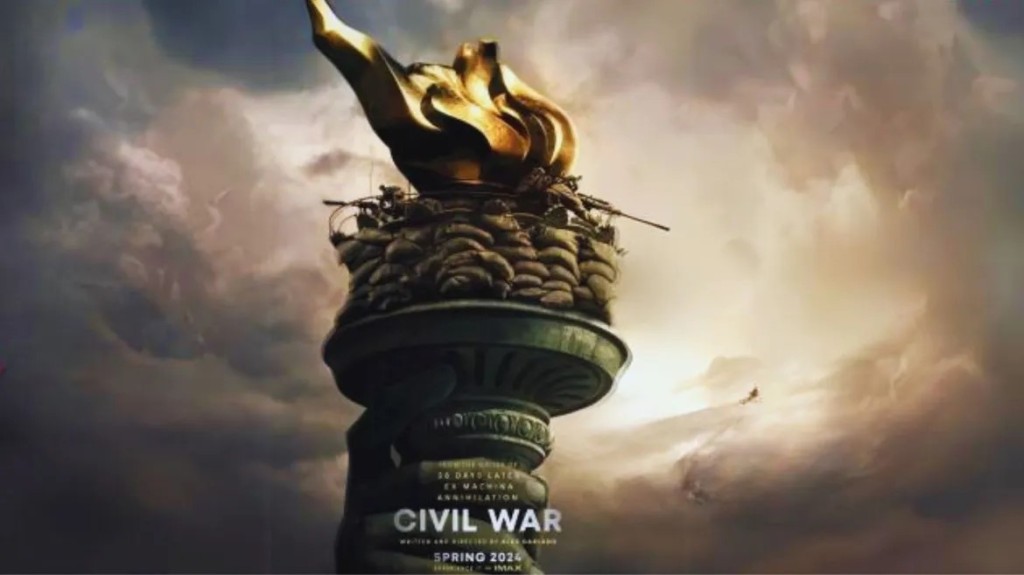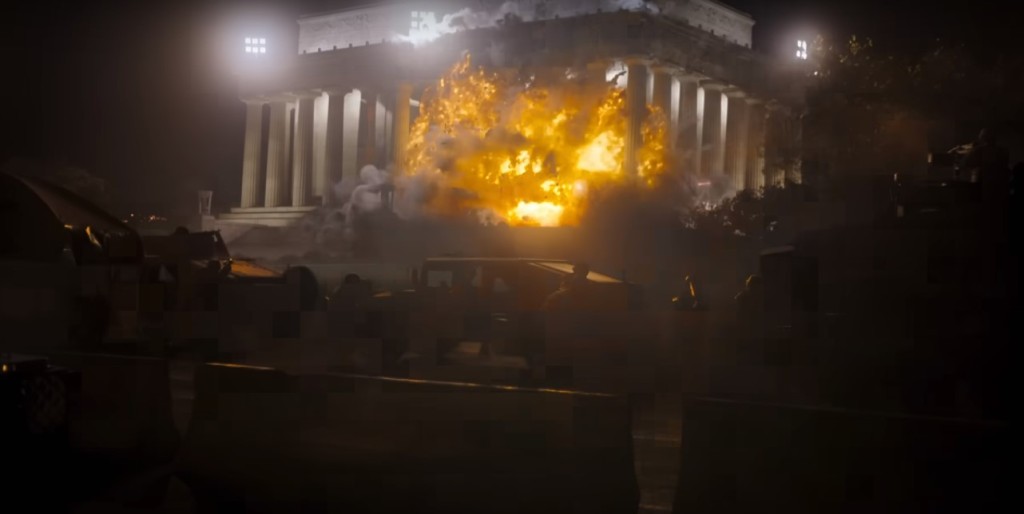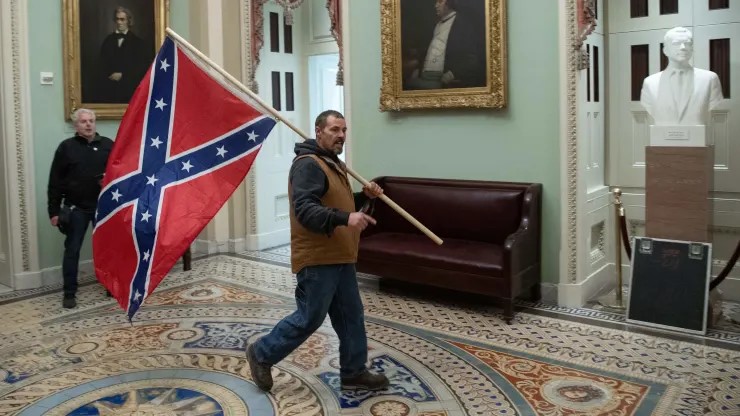
April 19, 2024 by David Silverberg
Back on Dec. 13, the independent, boutique movie studio A24 released a horrific-looking trailer for a movie called Civil War.
Its premise was that civil war breaks out in the United States between a president and his forces and an insurrectionist opposition. It was impossible to tell from the trailer whether the person portrayed as the president in the movie was supposed to be Joe Biden or Donald Trump or whether the insurrectionists were fighting to Make America Great Again (MAGA) or to preserve democracy.
The movie was released last weekend, on April 12, without the fanfare and the major marketing push that prospective blockbusters command. Nonetheless it earned $25.7 million at the box office on its opening weekend, a record for A24.
It is currently playing in Southwest Florida theaters.
Back in January, after watching the trailer, this author raised the question whether this movie would encourage would-be insurrectionists to take up arms against the government of the United States.
As stated at the time: “Whether pro or anti insurrection—or even anti-American—the most dangerous thing about this movie is that it will encourage those thinking of civil war and political violence to actually take up arms and make this fiction real. People living in deep red, heavily MAGA, gun-saturated places—like Southwest Florida—where there has already been talk of armed revolution, know that the line between fantasy and reality in this matter is already very thin.”
Having seen it, this author can address the question: is this movie likely to incite political violence and armed insurrection?
Rather than the usual domain for a movie review—the artistic, aesthetic and performance aspects—this review will try to answer that question.
But to understand the answer, one needs to know the setting, the characters, and the plot.
Background
Anyone thinking of seeing this movie should know at the outset that in its quest for authenticity it is extremely violent, bloodily graphic, literally gory, incredibly loud and full of profanity. There are a lot of unceremonious executions. It is rated R.
The civil war is already under way as the movie opens. The exact details of the conflict are only sketched out. The president, a man given to hyperbole and exaggeration who wears red ties, is in his (implied) illegitimate third term and has no intention of leaving the office.
“Western forces” consisting of Californian and Texan troops are at war with the federal government as is a “Florida alliance,” which has tried to make headway toward Washington, DC. Both have been beaten back, according to the president, who characterizes them as “secessionist.”
“Some are already calling it the greatest victory in the history of mankind,” he says.
In New York City, an experienced war photographer named Lee Smith, played by Kirsten Dunst, is photographing street protests that end in a bloody explosion, part of the rising tide of violence. Her driver and assistant is Joel, played by Brazilian-born actor, Wagner Moura.
Together they plan to travel to Washington, DC to cover the culmination of the rebellion. But as they talk of going, Sammy, played by Stephen McKinley Henderson, an old, lame New York Times reporter they know, cadges a ride. Also tagging along is Jessie, played by Cailee Spaeny, an aspiring war photographer who idolizes Lee (and who, in the biggest unreality of the entire movie, insists on shooting black and white film!).
So now the stereotypical quartet is complete: a hard-bitten, disillusioned veteran photog who has seen it all; a vaguely Latino sidekick; an ingénue and apprentice; and an old, wise, disabled black character providing special insights, a cliché known as the “magical Negro,” a term invented by director Spike Lee.
The movie could have been titled Four Tropes in a Truck.
No spoiler here: the psychological arc of the story is the maturation and brutal, real-world education of Jessie.
While in real life the road from New York to Washington, DC is pretty straightforward (Interstate 95, anyone?) the situation is such that the characters have to follow a roundabout route through the backroads of Pennsylvania and West Virginia.
This odyssey leads to a series of dystopian episodes that illustrate the disruption, inhumanity and confusion of civil war. (And also allow for filming tight, intimate scenes that don’t cost too much to set up.)
The film culminates in an elaborate, destructive assault on Washington and the White House, whose compound has been surrounded by a high, heavily fortified concrete wall, presumably built at the direction of this president.
Portraying civil war
The term “civil war” has been bandied about a great deal lately, mostly by MAGAs loyal to former President Donald Trump, who has also warned of a “bloodbath” if he’s not returned to office this November.

The people discussing “civil war” as a real possibility don’t appear to have a clue what real “civil war” means. They don’t appear to understand just what a tragedy, a horror, and an apocalypse a civil war constitutes. When Trump discusses a “bloodbath” and his enablers, like Rep. Byron Donalds (R-19-Fla.), defend it, they’re not showing any real comprehension of what happens when a society and nation is viciously ripped apart; when neighbors, family, friends turn on each other—and lose their nearest and dearest at each other’s hands.
To some small degree the movie Civil War conveys this kind of holocaust.
There is one scene where the journalists are stopped by an armed man of indeterminate side. When they say they are Americans like him, he asks: “What kind of Americans?”

Their lives depend on their answers, but there’s no telling what his standards are or what kind of Americans he’s seeking.
This in some small way conveys the horror and mortal uncertainty of a civil war.
To me one of the most tragic and awful depictions in the movie is a battle between uniformed soldiers and US Secret Service agents in the halls of the White House.
To know US Secret Service agents is to know some of the most patriotic, loyal, dedicated, highly-trained servants of this country, many with military backgrounds, people whose lives are on the line daily in the performance of their duties. To see them pitted—even fictionally—against fellow American soldiers really brings home the tragedy and horror of what a “civil war” truly means.
In a sense Civil War serves a constructive role in bringing all this horror this home. But the large number of appalling incidents and images also desensitizes the viewer to the brutality of what’s happening so that by the end, these occurrences are just a matter of course, exactly as Jessie learns to experience them.
This desensitization occurred during America’s real Civil War too. At the very outset northerners were appalled in 1861 by the killing of a single Union officer, Col. Elmer Ellsworth, when he was shot taking down a Confederate flag in Alexandria, Va. He was the first Union soldier to die and his death made headlines. By the end of the conflict in 1865, over 600,000 Americans were dead, their passing just statistics in the newspapers of the time.
Americans received a foretaste of real civil war on Jan. 6, 2021, when Trump pitted thousands of his followers against the US Congress and the Capitol Police. American Trumpers beat and battered American police officers doing their duty protecting the American Capitol. Americans attempted to lynch an American Vice President. It is remarkable that only one rioter was shot and that plans to use lethal force against members of Congress did not succeed. It could have been a real bloodbath.
A non-fiction documentary of Jan. 6 could serve as a depiction of a second American civil war instead of the movie’s fictional portrayal.
(And on a personal note: As a journalist I had the privilege during my career of being granted entry to the White House and always approached that mansion with a sense of respect and even awe. It was wrenching to watch even a replica of hallways I had known wrecked in the movie, just as much as it was devastating to watch Capitol corridors I had walked defiled and vandalized on Jan. 6. As though to make things worse, the movie shows the Lincoln Memorial attacked, the same building before whose steps I took my wedding vows on a boat on the Potomac. Every one of these sacred, meaningful sites has now been devastated in fact or in fiction. Next, no doubt, will come the turn of the Supreme Court—and if the justices rule that the Jan. 6 rioters go free from charges of obstructing government, then they deserve what they get when their chambers are invaded and vandalized in their turn.)

Does it incite?
Will this movie inspire someone to take up arms and violently try to overthrow the Constitution and the government of the United States?
Probably not—at least from a standing start. However, a person already inclined to use violence might find additional motivation from this movie.
The movie is likely to inspire at least one imitative mass shooting or attack on a soft target like a peaceful gathering or a theater. If that happens, investigators should ask if the perpetrators saw the film and were incited by it.
Almost as damaging as possible incitement is the fact that movie posits lethal violence as a political solution. That is unacceptable in a civil society governed by law. In a society ripped apart by civil war violence is the last solution left but—mercifully—America is not there now, at least to the point of widespread disorder.
That should never be allowed to happen in America. It’s one more reason that the concept of civil war is so abhorrent on so many levels, even in fictional depictions.
Anti-Trump or anti-Union?
It’s clear that the President, played by Nick Offerman, is a portrayal of Donald Trump. MAGAs, however, may see the situation through the lens of President Joe Biden as the overstepping tyrant in the movie, justifying armed resistance.
However, the real political threat portrayed in the movie is the notion of secession from the United States by violent means. After all, the overall political situation in the movie is one of states revolting against a hijacked federal government—although the notion of Florida rising up against Trump or a California-Texas alliance is pretty far-fetched at the moment.
Still, secession is rearing its head again and expressing itself in anti-federal actions, particularly in Florida and Texas.
Daniel Miller, president of the Texas Nationalist Movement, stated that the movie was “not as implausible as some people would have you believe” and was “pouring gasoline on the fire” of a Texas secessionist movement that has been called “Texit.”
The resistance of the governors of Florida and Texas to federal authority has been called “soft secession” and it is likely to go further. They continue defying federal authority, including that of the Supreme Court.
Even at the grassroots level, commissioners in Collier County, Fla., have passed an ordinance reserving the right to ignore federal law, effectively nullifying national rules they don’t like.
So the movie revives the idea of a state-based secession movement, an argument that was seemingly settled in 1865.

Takeaways
To answer the first question any movie review should answer: Should you go see the movie?
If you enjoy extreme violence, gore and chaos, yes. But if you don’t, your life won’t be any worse for skipping it. If you do see it, it’s unlikely to profoundly change your outlook or worldview.
But in a larger sense, and looking more broadly, one hopes this film might serve to dampen down the threats of armed insurrection, violence, bloodbaths and secession.
One can understand what inspired its creation and the desire to produce it. Its producers have every right to present it.
Fortunately, it is not an unmistakable incitement to civil disorder and insurrection. It doesn’t call on viewers to take up arms and go to war.
But neither is it a clear deterrent.
It shows the horrors of civil war and what that would entail at ground level. But it doesn’t convey the full, deep meaning of what civil war would do to America and the full magnitude of the disaster that civil war imposes on any society.
Ultimately, a civil war in America like that portrayed would be a historic tragedy of staggering proportions at every level—globally, nationally and individually.
If the movie inspires anything constructive it should inspire a determination never to have events like those portrayed occur. One would hope it would inspire the people of the United States to reject divisiveness, insurrection, criminality and treason and, out of diversity, forge unity—“E Pluribus Unum,” as America’s first motto stated. It should inspire allegiance to the Constitution and the rule of law and the realization that a common future trumps all allegiance or obedience to any single, violence-spewing, delusional individual.
If not, the movie Civil War might better be titled Putin’s Dream.
Liberty lives in light
© 2024 by David Silverberg






